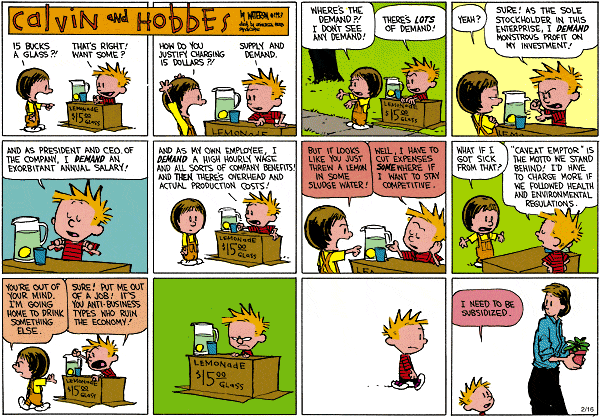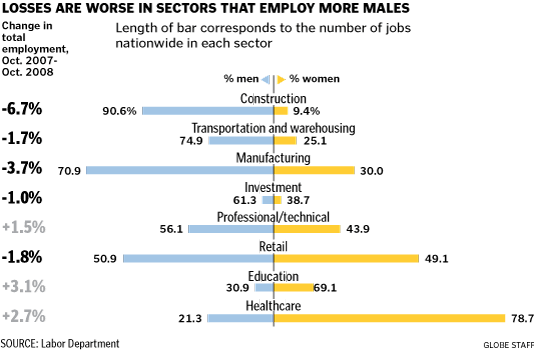From a microeconomics exam recently. The source article is “How a Drug Maker Tries to Outwit Generics” from the WSJ. (If that link doesn’t work, here is a PDF of the fulltext.)
Describe the nature of demand for Provigil. How much market power is there and why? If Cephalon raised the price of Provigil by 74%, with no apparent increase in production costs, does that mean that Cephalon was not initially pricing to maximize profits from Provigil? By raising the price, are they now profit-maximizing? Discuss. How would you expect the introduction of generics to affect the demand for Provigil? The price of Provigil has been raised before Nuvigil is launched. Discuss how the demand for Nuvigil would have been affected if the price of Provigil was not increased. Evaluate Cephalon’s strategy as a means of achieving its goal of corporate profit maximization.
Provigil is in extremely high demand; the trouble is that it is expensive, and it is almost never covered by people’s insurance. Right now, the average wholesale price (AWP) for 30 count of Provigil 200mg is $361. Provigil is also in an interesting place in terms of patent protection. It’s not a new drug, and through manipulating pharmaceutical patent law, Cephalon (who acquired the IP for the drug when they bought out Lafon) has been able to extend the life of the patent two or three times.
In healthcare, supply and demand do not function freely. In Provigil’s case, there is a distortion: one needs a prescription to buy it. In terms of price, there is another distortion: third party insurers will not pay for it. (9 out of 10 times it requires a prior authorization, which is almost always denied.) There are substitutes for Provigil. While it is the only drug of its kind, the stimulant ADHD medications promote wakefulness as well, though they often have other undesirable side effects, and are contraindicated in patients with anxiety and panic disorders and in patients with cardiac arrhythmias, hypertension, etc. Provigil, with its different mechanism of action, does not have these limitations because it does not function like drinking a cup of coffee. It simply removes fatigue and promotes wakefulness in the same way that it’s opposite, Benadryl, makes you sleepy and dopey. (Indeed, Benadryl is a messy antihistamine that works in the body and in the brain, and Provigil is a pro-histamine that works only in the brain.)
Because of the lack of competition within the pro-histamine drug class, Cephalon does have some market power. In my view, Cephalon was not profit maximizing for the long-term until these recent price hikes (more on that in a bit), because Provigil has always been expensive relative to its other patent-protected, cross-class competition (ADHD meds). Had they priced their medications right along at $100-150/month, they might have made up in volume what they would have lost in price. It’s not possible for me to know that, but I know that there is quite a bit of off-label demand from prescribers who would like to use Provigil, but cannot because it’s too expensive to buy out of pocket for most patients, and the majority of insurers will not cover it. The only way to know this for sure is to wait until the generic is released, and then see if there is a generic modafinil boom. I expect that there will be because it’s an excellent drug for many conditions that it’s not technically indicated for. (When I did graduate psychopharmacology, the one of the answers for many of our case studies was often modafinil, with the inside joke being “Just kidding, it won’t be covered so let’s not waste our time.”)
Now that Cephalon has raised the price by 74%, they are potentially sacrificing profits for the short-term, but maximizing them for the long-term. In the short-term, they are only potentially sacrificing profits because Provigil is never covered without a prior authorization to begin with. As patients not buying the drug out of pocket all have PAs in effect, that authorization does not expire just because there’s a price bump. Those prescribers who are successful in getting Provigil approved for their patients are unlikely to have a harder time getting it approved now that the price has gone up, because that’s not how the PA process works (even though I know that’s probably counter-intuitive).
What Cephalon will do is bump Provigil’s price while there’s still a brief amount of time left on its patent. Then they will release Nuvigil, while Provigil still has some patent life left. (Usually it’s a 6 to 9 month window on the patent for the old drug.) Nuvigil, priced in a more friendly fashion will almost immediately replace Provigil as the drug of choice. Cephalon will fund lots of studies that show that Nuvigil works great for those off-label things that prescribers have been using Provigil right along for, they will win FDA approval to use Nuvigil for these now-approved indications, and they’ll market the hell out of Nuvigil for these new uses.
In the meantime, the patent protection on Provigil will come to an end, just as Cephalon’s marketing campaign for Nuvigil is winding down, and most patients that were on Provigil will have been switched to Nuvigil (because it’s cheaper and ostensibly “better”), and then generic Provigil will hit.
For about two months, the prescription benefit managers (PBMs) will do nothing. People will fill their monthly Nuvigil scripts, and then the clinical pharmacists working for the PBM will have finished their research, made their recommendations, and the formularies will change. Nuvigil will suddenly require a prior authorization, and pharmacies will begin faxing doctors’ offices to change from Nuvigil to the newly-generic Provigil. And doctors will sign off on this switch back to the old drug because doing prior authorizations is a giant pain in the rear, and the opportunity costs associated with taking 15 extra minutes to fill out paperwork for each Nuvigil Rx is enormous.
Nonetheless, Cephalon is profit-maximizing in the long-run by doing this because despite the delayed shift from Nuvigil back to the generic Provigil, there will be some folks that remain on the Nuvigil. How many will depend on pricing. So long as Cephalon isn’t price-gouging on the new drug the way they are on the old one, PBMs may be more lax about requiring PAs or trials of other drugs before approving the Nuvigil. (Instituting a PA, after all, creates inefficiency and requires the hiring of more personnel to process the PAs, etc.) Gouging is, of course, a relative thing.
This kind of behavior happens all the time in the prescription drug industry. AstraZeneca did it with Prilosec. They jacked the price of 40mg Prilosec way up (AWP is currently $247, though it was over $300 just a few months ago), released 40mg Nexium at a lower price (AWP currently at $181), and then generic Prilosec hit the market, and took back a bunch of marketshare, but not all. Nexium remains a very profitable drug, despite there being the evidence that suggests that it is only marginally better than Prilosec, if that. (Most AstraZeneca-funded studies compared 20mg of Prilosec to 40mg of Nexium, and only published this detail in the fine print. I actually had a talk with an AstraZeneca sales manager about it a few years back after he moved to Forrest, and he admitted that Nexium was only created to perpetuate the revenue stream.) In the industry, we call this game of patent-extension “evergreening” and there are a huge number of drugs that bear this label: Lexapro (based on Celexa), Nexium (Prilosec), Nuvigil (Provigil), Clarinex (Claritin), Xyzal (Zyrtec), Pristiq (Effexor), Trexima (Imitrex+Naprosyn); the list goes on and on and costs the healthcare system billions every year.
An example of a company that didn’t do this, and is NOT profit-maximizing is Sanofi-Aventis with Xyzal, which I mentioned above, and they ended up with a drug that was dead in the water on arrival. Xyzal was supposed to replace Zyrtec which was losing its patent protection, but because SA didn’t take the necessary steps the way Cephalon is and AstraZeneca did, their drug went nowhere. It was released about a year ago, and I can count on one hand the number of prescriptions I have filled for it. Zyrtec, on the other hand, was one of our fastest movers. (And is now available over the counter which killed script volume for it.) On the other hand, Sanofi-Aventis is still making money from the over-the-counter sale of the old Zyrtec, so they are maximizing profits in the second best way. (Having a patent monopoly for an Rx-only drug is more lucrative because you can charge prices that you’d never make up for even with the oceans of relatively undistorted free-market OTC volume.)
In my 8 years in the pharmaceutical industry, Cephalon is a company that I simultaneously loathe and admire. I dislike them because their drugs are very expensive when common sense suggests that they probably shouldn’t be (Provigil was invented in the 1970s). On the other hand, I find myself admiring them because they are incredibly legally savvy. If this savvy is present in their pricing discussions — and I have no reason to think that it is not — there is a good possibility that they are indeed profit-maximizing within their legal constraints. I know that earlier I suggested earlier that they might make more money in volume if they lowered their prices, but most PAs will not be approved unless the indication is on-label or you are a specialist, and since Provigil only has one indication, they might indeed be profit maximizing inasmuch as they can realistically be in a heavily distorted market. The information asymmetry here means I can do no more than speculate.

